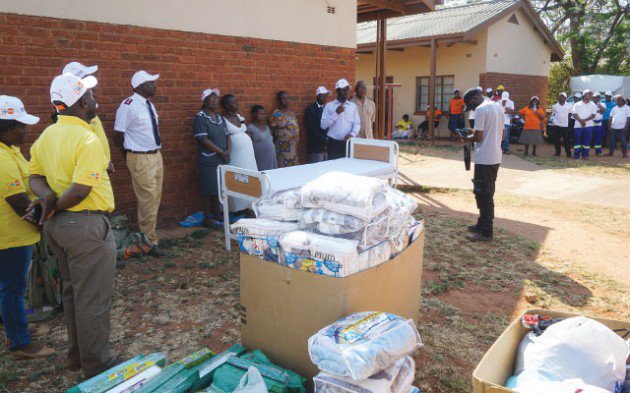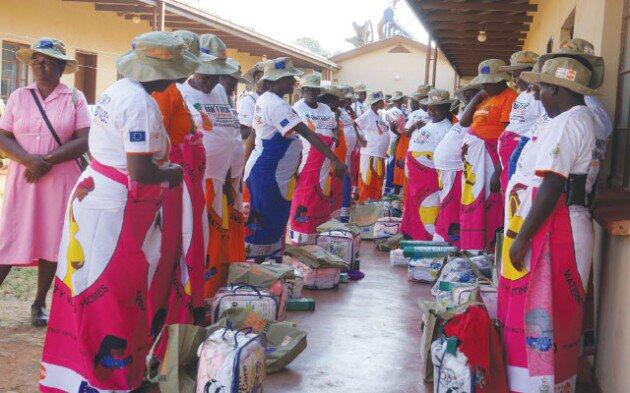It’s not about a gleaming waiting room, with tiled floors, aircon, mounted televisions, beautiful furniture, portraits, magazines, coffee mixers and chilled water dispensers. It’s not about custom beds, cabinets and glass panelled waiting rooms with expensive lighting.
For Esther Alimu (32) of Jaji village in Chiweshe under Chief Negomo, a waiting room is more about a basic space with a simple bed, clean environment and a welcoming atmosphere for pregnant and expecting mothers. She believes the construction of maternity waiting homes which can accommodate 80 women at the Salvation Army-run Howard Mission Hospital in Chiweshe communal lands, about 80km north of the capital, Harare, is a great investment.
“I am very happy with this shelter for pregnant women,” says Alimu, who is pregnant and expecting. “It’s saving our lives. I have had challenges with my babies not moving. I have to get induced so that I may have a successful delivery. That is why it is essential for me to come to this waiting shelter towards my delivering date where nurses can monitor my pregnancy.”
"I am very happy with this shelter for pregnant women. It's saving our lives", Esther Alimu (23)
Like most rural women, Alimu faces numerous challenges when it comes accessing healthcare services. Chiweshe district in Masholand Central province has few ambulances and it can take three or more hours before they respond to a call. During the rainy season when the roads are impassable, there are no ambulance services at all. Women have to walk long distances to seek help at clinics and hospitals.
The distribution of health care facilities is unequal and poverty is a major barrier to access health. The provision of shelters or maternity waiting homes is helping to reduce maternal and perinatal mortality by improving access to skilled birth attendance and emergency specialised care, particularly for women in rural areas.
“There are a few ambulances and they don’t come where we live. It’s too remote,” Alimu says. “It’s long a distance for us to go to the nearest point where we can get transport. That can be challenging when one is closer to giving birth. A woman needs to be near a hospital during that time because only a professional can help you deliver the baby safely.”

The shelters have numerous benefits for the women. They help rural women to get ante-natal check-ups, newborn care and identifying problems during labour. Maternity shelters are designed to prevent haemorrhage, which health experts say is the major contributor of deaths for women during delivery. Howard Hospital matron, Aquilina Chinembiri says more women are now coming to the hospital after the completion of maternity waiting homes. She says the hospital serves a population of more than 24 000 people. More than 1 000 are expected to deliver babies at the hospital.
“This hospital is run by three doctors and 46 nurses including matrons and tutors. The maternity department is very busy because our average deliveries per month are 180. Many patients from clinics in Chiweshe and other surrounding areas are referred to us because of the services we offer. Only a few cases are referred to major referral hospitals,” Chinembiri says.
The waiting room area at the hospital is spacious and accommodates about 80 women.
“The demand is high and we now prioritise giving accommodation to those who come from far away areas and require urgent attention,” says Chinembiri.
First preference, she says, is given to those who are pregnant with their first baby, need to deliver through caesarean section, have difficult deliveries, high blood pressure and those having their fifth child. Government, with the support of local and international funding partners, has built maternity waiting homes at various clinics and hospitals in rural areas.
These are places where expecting mothers can stay during the last six weeks of their pregnancies. The maternity waiting shelters at Howard Hospital, built with funding from Grant Thornton, United Nations Population Fund (UNFPA), Nyaradzo Funeral Assurance Company and others, aim to reduce maternal mortality and educate new mothers about how to look after their newborns. Many women are already benefiting from the maternity waiting homes.
“This is my first pregnancy and there are a lot of things I didn’t know about pregnancy. Nurses teach us about the importance of breast feeding our babies and demonstrate delivering positions among other things. We are learning a lot from this shelter. It’s preparing us for motherhood,” says Mirirai Mutuva (18) of Ruwiza village under Chief Makape.
Other women spoke of how the maternity waiting shelters had saved them from death and other health complications.
“The shelters are saving lives. Some women die while giving birth because they stay far away from hospitals. When you are here, you can easily seek help from nurses and doctors at the hospital. You can quickly be assisted if you face complications,” Veronica Zembeni (25), Mawore Farm, Mvurwi.
Delivering from home, she says, has numerous risks which can lead to death.
“Giving birth at home with the assistance of elderly women has put many women at risk,” Zembeni says. “Many die if things don’t go well. Training and improving the skills of anambuya nyamukuta (midwives) is important to save lives.”
As a result of the waiting shelters, the number of pregnant women receiving prenatal care has increased significantly, while mothers accessing care after giving birth has nearly tripled.
“We only had one maternity death last year and none so far this year. The number of mothers coming for help after giving birth has also gone up tremendously. It’s a positive sign, shelters are improving the situation,” said Dr Aaron Museka, chief medical officer at Howard Mission Hospital.
The number of expecting mothers giving birth at home has decreased and hopes are high that maternal mortality will decrease too, with the increased use of maternity shelters. Says Christina Muzerengi, a director at Grant Thornton: “We go out into the community every year to reach out as part of our social responsibility.
“What we have managed to do will leave a good mark on the lives of both these mothers and the babies they will have and we are delighted by that,” Christina Muzerengi, Grant Thornton Director
Adds Dr Cremence Tshuma, provincial medical director of Mashonaland Central: “The donations are helping to improve the quality of services especially for our expecting mothers and we are privileged as a province to have received such assistance in this area.” Moves to construct maternity waiting homes are now widely seen as one of the ways to reduce Zimbabwe’s high maternal mortality rate, which the United Nations says is now about 614 deaths in every 100 000 pregnancies.
An average of seven women die while giving birth in Zimbabwe weekly, according to the Health and Child Care Ministry figures. More than 200 women have died so far this year while giving birth. The country’s high rate of maternal mortality is partly due to the long distances women travel to reach clinics and hospitals.
Most women in rural areas give birth at home with the aid of a traditional birth attendant. Zimbabwe is targeting to build more maternity waiting shelters to get more expectant mothers into clinics staffed by at least a general nurse and a midwife. Maternal mortality is unacceptably high in most developing countries, according to the World Health Organisation.
About 830 women die from pregnancy or childbirth-related complications around the world every day. The WHO estimates that in 2015, more than 300 000 women died in pregnancy related complications. In sub-Saharan Africa, maternal deaths have decreased from 846 deaths per 100 000 in 2000 to 546 deaths per 100 000 live births in 2015.
By Tatenda Charamba (Features Writer, The Herald)


